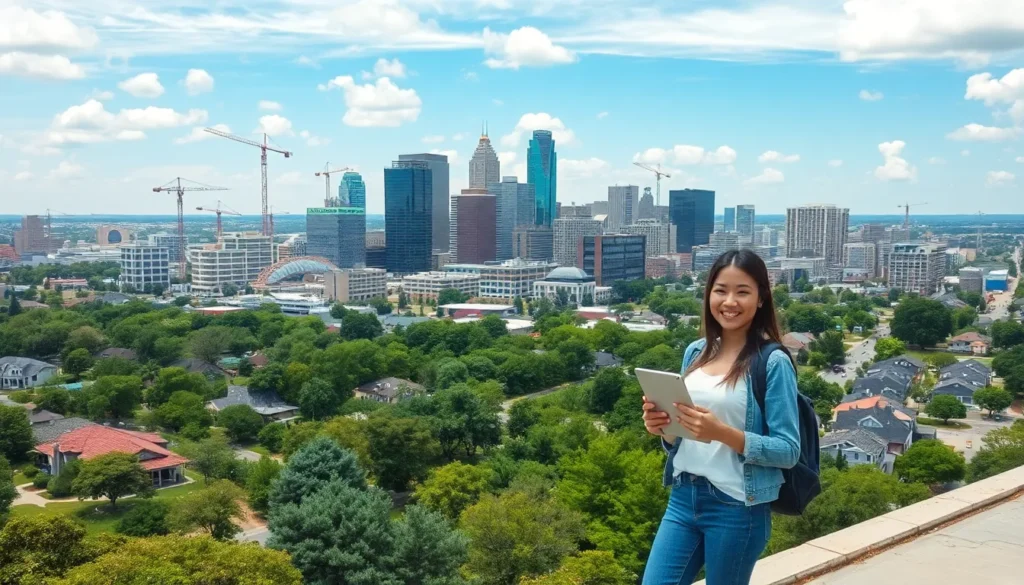In the great urban planning showdown, two rival factions face off: the NIMBYs and the YIMBYs. NIMBY, or “Not In My Backyard,” champions the cause of keeping things just the way they are, while YIMBY, or “Yes In My Backyard,” throws caution to the wind and embraces growth and change. It’s a classic tale of the old guard versus the new wave, where everyone thinks they know what’s best for their neighborhood.
Table of Contents
ToggleOverview of NIMBY vs YIMBY Debates
NIMBY (Not In My Backyard) represents residents opposing new developments in their communities. This group often raises concerns regarding potential impacts on property values, environmental degradation, and community character. They typically resist projects like affordable housing, commercial developments, or infrastructure improvements, fearing negative consequences.
Conversely, YIMBY (Yes In My Backyard) advocates for increased development and urban growth. Supporters argue that new housing and public amenities benefit everyone, promoting diversity and inclusion. YIMBYs emphasize the importance of addressing housing shortages and combating rising living costs through expansion and innovation.
This ongoing debate encompasses a variety of topics, including housing affordability, urban sprawl, and environmental sustainability. Each group presents valid points, with NIMBYs highlighting the need to protect existing neighborhoods and YIMBYs focusing on addressing pressing urban issues. For example, research indicates that communities with more housing options can improve overall affordability and accessibility.
Local governments often find themselves caught between these opposing viewpoints. Decisions regarding zoning laws and development projects reflect the complexities of balancing community interests. Engaging in public forums, city planners frequently encounter passionate arguments from both sides. Understanding these dynamics fosters a more informed approach to urban development and planning.
Ultimately, the NIMBY vs YIMBY debates illustrate broader societal tensions over growth and preservation. Each group’s stance reveals underlying values about community identity, equity, and future directions. The outcome of these discussions will significantly shape urban landscapes in the coming years.
Key Concepts in NIMBY vs YIMBY
Understanding the fundamental concepts of NIMBY and YIMBY provides clarity on this urban planning debate. Each group’s stance shapes the future of cities.
Definitions of NIMBY and YIMBY
NIMBY, or Not In My Backyard, describes individuals who resist development projects in their local area. Concerns often center on property values, environmental impact, and community character. YIMBY, or Yes In My Backyard, supports new development, advocating for growth and innovation. Proponents argue that such developments address housing shortages and promote social equity. Both groups reflect different attitudes toward community change.
Historical Context
Historically, NIMBYism became prominent during the 20th century as suburban expansion sparked fears of change. Many local communities opposed developments seen as threatening to their established way of life. Conversely, YIMBY movements gained traction in response to housing crises in major urban areas. Efforts intensified after the 2008 financial crisis, as rising housing costs challenged affordability. This ongoing tug-of-war illustrates the evolution of urban policy debates influenced by social and economic factors.
Arguments for NIMBY
NIMBY advocates emphasize community preservation and environmental protection. Their concerns often stem from the impacts that development can have on local neighborhoods and ecosystems.
Preservation of Community Character
NIMBY supporters often worry about losing their neighborhood’s unique character. They argue that new developments can alter the architectural styles and cultural heritage that define communities. Residents fear gentrification, which can displace long-time residents and create a loss of local identity. Maintaining existing community structures fosters a sense of belonging and stability. Communities thrive when they honor their history and the relationships among neighbors, which new housing or commercial projects can disrupt.
Environmental Concerns
Environmental preservation plays a crucial role in NIMBY arguments. Many residents express apprehension about the potential for increased pollution from new developments. They believe that infrastructure projects can contribute to habitat destruction, harming local wildlife and ecosystems. Protecting green spaces and natural resources becomes a top priority to ensure sustainable living conditions. Urban sprawl leads to challenges like traffic congestion and air quality issues. By resisting unwanted developments, NIMBY proponents seek to foster a healthier environment that benefits all residents.
Arguments for YIMBY
YIMBY advocates present compelling arguments focused on enhancing urban living conditions. Their support for new housing and infrastructure plays a crucial role in addressing existing challenges.
Housing Affordability
Housing affordability represents a pressing issue in many urban areas. New developments introduce affordable housing options, easing financial burdens for many residents. Communities benefit as diverse income groups can coexist in newly accessible neighborhoods. Addressing high rents forms the backbone of YIMBY arguments. The rise in housing availability reduces competitive bidding, thereby stabilizing prices. As a result, individuals and families no longer face insurmountable barriers to homeownership. Local economies strengthen with increased housing supply, ultimately fueling growth.
Urban Development Benefits
Urban development brings numerous advantages to communities. Increased density encourages efficient public transportation and reduces overall emissions. Enhanced amenities and services follow alongside new residential projects, creating vibrant neighborhoods. Additionally, development contributes to local job creation, stimulating employment opportunities across various sectors. Improved infrastructure supports long-term sustainability, especially when addressing aging systems. Communities gain recreational spaces and public facilities through innovative projects, enhancing overall quality of life. Lastly, urban development fosters inclusivity, allowing different demographics to thrive within shared environments.
Case Studies on NIMBY vs YIMBY Debates
Numerous case studies illustrate the dynamics of NIMBY and YIMBY debates across different cities. In San Francisco, the push for new housing developments often encounters fierce opposition from NIMBY groups concerned about gentrification and neighborhood character. Developers face delays as objections arise over building heights and neighborhood aesthetics, creating a complex planning environment.
Contrastingly, in Minneapolis, city officials adopted a YIMBY approach by eliminating single-family zoning. Leaders aimed to address the housing shortage and promote diversity. This shift exemplified a commitment to inclusivity, supporting the construction of multi-family units in previously restricted areas.
Chicago offers another perspective, where the local government strives to balance both viewpoints. In response to NIMBY concerns about green spaces, city planners integrated affordable housing with community parks, prioritizing environmental integrity along with development. Collaborative efforts exist to create dialogues between residents and urban planners, encouraging constructive feedback and easing tensions.
New York City also faced heated debates surrounding affordable housing projects. NIMBY advocates often protested against developments perceived as out of character with their neighborhoods. YIMBY supporters, however, emphasized the urgent need for more housing solutions, citing rising rents and long wait lists for public housing.
Seattle illustrates a successful YIMBY campaign through its housing policy reforms aimed at reducing barriers for builders. Zoning changes approved by city council members aimed to facilitate denser housing options. As a result, Seattle witnessed an increase in construction activities, improving housing availability amid a growing population.
These case studies reflect the ongoing tension between NIMBY and YIMBY ideologies. Details about each city’s approach highlight how municipalities navigate the complexities of urban planning while addressing concerns from both sides.
The NIMBY vs YIMBY debate underscores the complexities of urban development and community dynamics. Each side presents compelling arguments that reflect deeper societal values regarding growth and preservation. As cities continue to evolve and face pressing challenges like housing shortages and environmental concerns, finding common ground becomes essential.
Local governments and planners must navigate these conflicting perspectives to create sustainable solutions that honor community identity while promoting necessary change. The future of urban landscapes hinges on how effectively these discussions can lead to inclusive policies that benefit all residents. As the dialogue continues, the importance of understanding and addressing both NIMBY and YIMBY concerns will shape the cities of tomorrow.













